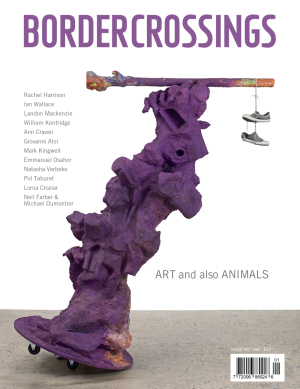“Technologies of Intuition” edited by Jennifer Fisher
Technologies of Intuition is an unique new anthology edited by artist, curator, academic and teacher Jennifer Fisher and co-produced by Toronto’s YYZ Books, Winnipeg’s award-winning MAWA: Mentoring Artists for Women’s Art, and Fisher’s own DisplayCult curatorial collective. Its title borrows from a Foucaultian phrase, “technologies of the self,” which identifies meditation, dream interpretation and other techniques as learnable tools (or technologies) for attaining states of “happiness, purity [and] wisdom.”
Between the covers of Technologies, 25 writers, artists and critics elaborate some of their own projects or perspectives involving “technologies of intuition.” There are a few “big names” in the mix—Karen Finley, Marina Abramovic, Linda Montano, Carolee Schneemann—as well as contributors less well-known but established in their own right, such as Beth Seaton, Paula Thomson and Barbara Balfour.
Fisher’s introduction lays out the premise of the book: intuition is fundamental to artists’ processes, but is marginalized in art theory and criticism. Consequently, the book’s “fulcrum,” Fisher writes, “focuses on artistic practices involved with accessing a state of intuition,” intuition here defined as “looking within for direction or protectiveness.”
Following from this premise, contributors looked at or applied a variety of practices to investigating intuition, including mediumship, divination, shamanism, communing with the dead, automatic writing and clairvoyance. Individual takes range from an hilarious feminist Tarot (Bev Pike) and unexpected collaboration with mediums (Valerie Lamontagne, Katarina Soukup) to friendly instructions on how to reclaim intuition (Linda Montano) and analyses on neuropsychological states of artists in intuitive thrall (Paula Thomson). Other contributors create psychic portraits (Karen Finley, Chrysanne Stathcos), identify parts of their bodies as intuitive (Karen Trask, Barbara Balfour) and examine the role of cinema in understanding the paranormal (Zoe Beloff). Tone and method range from rigorous academic scholarship to casual, first-person accounts.
Technologies of Intuition is a compelling project; ultimately, its most powerful elements come from those who speak intuitively (non-academically) and from those whose art making reflects on the theme in a humorous way. Though the more academic, analytical, art historical essays are intelligent, reasoned and enlightening in their own right, their very form seems to work against the theme of felt realities and intuitive, rather than intellectual, drives.
For example, the texts on or by Abramovic, Botescu, Montano and Hiller speak very plainly (either in the voice of the artist themselves, or through described actions) about the intuitive process and its results, reminding artists and critics alike— via their very voice and form—of the necessity to develop and heed this source, and of the potential benefits of doing same. Pike and Bristol also engage the subject matter in a disarming, amusing, side-door-of-the- consciousness way with their satirically edged artistic projects. In contrast, the more scholarly texts, such as Beloff’s and Lavigne’s, pull readers into the rational, ordered, decoding, “head” part of the brain, rather than into the instinctive, experience-led, “gut” part of the brain, which several note as intuition’s neocortex.
Another problematic aspect of Technologies is confusion about its feminist parameters. Conceptually, the book is framed as being about intuition in the arts, but few male artists—who, one presumes, are not immune to intuition—are noted in relation to these concerns.
One reason this almost exclusive focus on women seems problematic is that this focus is not sufficiently— or is, perhaps, even contradictorily— addressed in the book’s introduction. There, Fisher writes that one should not stereotype all women in an essentialist sense as being more intuitive than men. She implies this is a limiting assumption that many “second-wave” feminists made, and that the same mistake should not be repeated. But no alternative context or “wave,” feminist or otherwise, is offered as insight into how the book was curated.
Carolyn Bell Farrell’s description of curating, essayed in Technologies as an intuition-led “divining process,” might, one imagines, have reflected Fisher’s own decision making regarding the book’s content. That is—perhaps all the artists and writers she was interested in for intuitive work just happened to be women. Still, in not articulating the framework for her process— even if it were simply to say “I’m divining”—Fisher’s under-contextualized result (a text on intuition that features only women) actually reinforces a “second-wave” essentialist viewpoint.
The fact that Technologies was partly funded by MAWA also generates some expectation that the editor would have elaborated a more detailed position in relation to feminist geographies, a position worth hearing. These problems indicate, perhaps, a “haunting” of the text itself by past art histories—feminist and otherwise. This type of “haunting” is elaborated in a good Technologies essay by Jo Applin. So, just as the text attempts to deny or restrict connections to a second-wave feminist past (and maybe other scary things?), its gauzy, ectomorphic presence hovers throughout. I say maybe it’s time for a séance. ■
Technologies of Intuition, edited by Jennifer Fisher, YYZ Books/MAWA/ DisplayCult, 2006, softcover, 272 pp, $29.95.
Leah Sandals writes on art for a variety of newspapers and magazines. She is also the Arts Editor of Spacing magazine.

